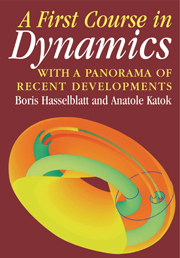Book contents
- Frontmatter
- Contents
- Preface
- 1 Introduction
- PART 1 A COURSE IN DYNAMICS: FROM SIMPLE TO COMPLICATED BEHAVIOR
- 2 Systems with Stable Asymptotic Behavior
- 3 Linear Maps and Linear Differential Equations
- 4 Recurrence and Equidistribution on the Circle
- 5 Recurrence and Equidistribution in Higher Dimension
- 6 Conservative Systems
- 7 Simple Systems with Complicated Orbit Structure
- 8 Entropy and Chaos
- PART 2 PANORAMA OF DYNAMICAL SYSTEMS
- Reading
- APPENDIX
- Hints and Answers
- Solutions
- Index
4 - Recurrence and Equidistribution on the Circle
Published online by Cambridge University Press: 05 June 2012
- Frontmatter
- Contents
- Preface
- 1 Introduction
- PART 1 A COURSE IN DYNAMICS: FROM SIMPLE TO COMPLICATED BEHAVIOR
- 2 Systems with Stable Asymptotic Behavior
- 3 Linear Maps and Linear Differential Equations
- 4 Recurrence and Equidistribution on the Circle
- 5 Recurrence and Equidistribution in Higher Dimension
- 6 Conservative Systems
- 7 Simple Systems with Complicated Orbit Structure
- 8 Entropy and Chaos
- PART 2 PANORAMA OF DYNAMICAL SYSTEMS
- Reading
- APPENDIX
- Hints and Answers
- Solutions
- Index
Summary
So far we concentrated on dynamical systems where the asymptotic behavior can be described simply: Every orbit was either fixed (sometimes periodic) or was attracted to (possibly different) fixed points as the time approached positive and negative infinity. In several situations, such as Proposition 2.3.5, we showed that no other behavior is possible.
In this chapter we study a fundamentally different type of behavior. Analysts use the rather innocuous term “quasiperiodic” to describe it and to signify that it is not much more than a generalization of periodic behavior. But from the dynamical point of view this is a starting point for the understanding of nontrivial recurrence, the central paradigm of the theory of dynamical systems.
We begin with a careful study of this phenomenon in the simplest possible situation, circle rotations. In the second section this already gives a remarkable array of interesting applications. The final section extends some of our insights to nonlinear circle maps.
ROTATIONS OF THE CIRCLE
The description of our first example is surprisingly simple; it is, in fact, closely related to some of the linear dynamical systems that appeared in Chapter 3, specifically Section 3.1.8.4 with ρ = 1: For a linear system with a pair of complex conjugate eigenvalues of absolute value 1, complex behavior may appear on the invariant circles r = const. We now study these rotations of a circle.
Information
- Type
- Chapter
- Information
- A First Course in Dynamicswith a Panorama of Recent Developments, pp. 96 - 142Publisher: Cambridge University PressPrint publication year: 2003
